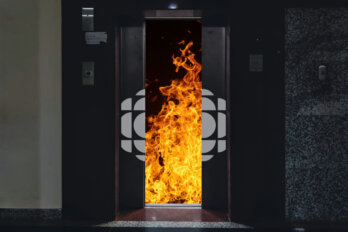In the studio from which he broadcasts his afternoon CBC radio show, the eyes of Rich Terfry’s heroes follow his every move. On the desk in the corner, where a few years ago you might have found a bust of Beethoven or a photo of Peter Gzowski in a fisherman’s sweater, there’s now a framed portrait of Joe DiMaggio, Mickey Mantle, and Ted Williams; tacked on the wall behind it are postcards and magazine cut-outs of Sun Ra, Elvis Presley, and Spider-Man. Giving me the grand tour, Terfry weaves his heroes’ stories together with his own. Growing up in Mount Uniacke, a small Nova Scotia town about forty kilometres northwest of Halifax, he had two passions: baseball and music. He was good enough at the former to attract a scout for the New York Yankees, but when a knee injury derailed that dream he turned to the latter, starting down a winding road that finds him hosting Radio 2 Drive, the jewel in the crown of CBC’s “New Radio 2.”
A year after the once classically focused station’s controversial pop-friendly facelift, Terfry has survived underwhelming ratings and howls of rage from embittered ex-listeners. And while the story is a long way from over, neither he nor the architects of the Radio 2 makeover show any signs of giving up on the project.
When the brain trust at CBC Radio went looking for a face for their reinvented Radio 2, they needed someone with an established cheering section among the nation’s tastemakers. Terfry seemed an obvious choice. Although he wasn’t a CBC insider, he had years of radio experience hosting a popular hip hop show on the Dalhousie campus station CKDU (where he was known as DJ Critical). As Buck 65, a veteran Canadian hip hop artist whose gravelly voice and gritty, sometimes nostalgic lyrics attracted endless comparisons to Tom Waits, he had access to a young, hip audience CBC had frequently courted but rarely won.
In the late 1990s, Buck 65 became affiliated with anticon., a San Francisco hip hop collective that was to underground hip hop what New York’s legendary Wu-Tang Clan once was to the genre’s mainstream. In 2002, he signed a major-label deal with Warner and in 2003 released Square. Later that year came Talkin’ Honky Blues, a departure from his previous albums’ low-fidelity style, incorporating more guitars and, on the twangy but no less funky “Wicked and Weird,” banjos. He had risen to the challenge of addressing a broader audience. Rolling Stone called him a “hot indie rapper.” The influential Village Voice critic Robert Christgau hailed Talkin’Honky Blues as “one of my favourite albums of the millennium.”
In Europe—France in particular—he was even more successful. “Les Inrockuptibles—basically the French Rolling Stone—picked Talkin’ Honky Blues as one of the best albums of 2003,” says Terfry. “The French just really picked up on that record, and it sold pretty well there. They came out and saw me in pretty big numbers—they still do.” So he hit the road, playing a series of European festivals, including the UK’s legendary Glastonbury Festival. A highlight was the Les Eurockéennes de Belfort festival near Belfort, France; the day’s headliners included PJ Harvey and reunited indie rock icons the Pixies. Later that year, he returned for another, even bigger festival just outside Paris called Rock en Seine. “It was the most people I’ve ever seen. It seemed like they dropped off the horizon. It was definitely over 50,000 people. I was alone onstage; it was just me with a turntable and a CD player or a computer or something like that. It’s a tall order, one guy, so I did everything I could to make it as big as possible and try to make people forget about that fact, that it was one guy up there trying to hold it all together.”
It was an auspicious beginning, but not all strong starts lead to stardom. When Warner declined to release Talkin’ Honky Blues, he fought his way out of his US contract. He then signed a deal with V2, which released a compilation of his previous material, This Right Here Is Buck 65, generating more critical acclaim. But V2 passed on his next CD, 2005’s Secret House Against the World, so his subsequent release, Situation, appeared in the US in 2007 on fellow anticon. alumnus Sage Francis’s Strange Famous Records. Situation was more musically conservative than Secret House, and far more focused and accessible, thanks in part to fellow Nova Scotia hip hop DJ Skratch Bastid’s bare-bones production. Still, Buck 65 had passed through the “buzz band” phase of his career. He had built an enviably loyal base and was still able to tour, but it was now a struggle.
On July 29, 2007, three months before the release of Situation, a journal entry appeared on his website, buck65.com:
“Lately I’ve been considering the idea of getting a regular job. I’m just considering it. Why? Well, I have given up on the idea of making money off records. It’s hopeless now. I hope soon to cut it out altogether—I’ll just give music away (that will likely mean not manufacturing a physical product anymore).
… For someone like me to actually make a living off touring, I have to do it almost constantly. And while touring and having adventures can be fun, you must give up on the idea of having a real life. That’s a hefty price. Not to mention the toll touring takes on one’s body.
… It’s just a thought. But if anyone wants to give me a job (I’ll consider just about anything), get in touch.”
And someone did.
Every Monday to Friday, Rich Terfry makes the forty-minute walk from his house in Toronto’s west end to CBC’s headquarters, near the centre of the city’s business district. He doesn’t own a car or a cellphone, and by his own account rarely leaves his neighbourhood except to go to the studio, where he gets ready to serve up three hours of music, nearly all of which is Canadian. Part of the show’s mandate, explains senior producer Michelle Parise, is to focus on homegrown product, mostly (but not exclusively) of the singer-songwriter variety. While CBC’s mandate calls for 50 percent Canadian content, Drive’s goal is 75 percent. To make that happen, Parise and the rest of the Drive team, including executive producer of daytime programming Kai Black and associate producer Kelly Cutrara, have been building what she describes as a “huge master library of artists.”
An average Drive playlist consists of mellow acoustic roots-rock and folk (Bruce Cockburn, Broken Social Scene member Jason Collett), the occasional mainstream American star (Beck and Ray LaMontagne have been known to pop up), and whatever oddball choices Terfry and Parise et al. can sneak in, like London, Ontario, rapper Shad. “I think Shad is incredibly talented,” Terfry insists, “and I’m pushing the hell out of him.” One of the criticisms of the Radio 2 makeover was that it was fuelled by commercial considerations, but the Drive team’s affection for the music they play is obvious and sincere. For instance, Terfry loves to hold forth on the connections between the Nova Scotia fiddle music he grew up hearing—and, at the time, loathing—and the blues, jazz, and rock ’n’ roll traditions that flourished in the American South.
“It’s been really interesting for me in the past three years,” he explains, “making trips to Louisiana and discovering how aware people are of the link. I just need to mention I’m from Nova Scotia, and kids even younger than I am know about the history between the two places. Even knowing that Cajun is a mispronunciation of ‘Acadian,’ I mean, that’s a pretty direct thing. There are links to some extremely important musical history, and if it wasn’t for the British expelling the French from Nova Scotia, who knows if history would have played itself out in the same way? ”
Terfry’s easy manner and almost downhome charm have more in common with small-town AM radio than with the sometimes stuffy formality of CBC (he remembers his father listening to a local country radio station, an early influence). He peppers his asides with the occasional “no sir” and “you bet,” but there’s no irony in his manner—his enthusiasm is infectious. This was what CBC Radio programming director Chris Boyce responded to during the audition process. “He has sort of a low-key delivery that sounds… it’s just so different than a lot of other tapes I’d heard,” says Boyce. “Because radio is such a personal, intimate medium, you need to actually want to spend time with the person who’s on the air. Rich is the kind of guy I think everyone would want to sit down with and have him spin some tunes for you.”
Not all of Radio 2’s former listeners would agree. According to Bureau of Broadcast Measurement data cited by Stand on Guard for CBC, a blog lobbying for the reinstatement of classical programming, Radio 2’s market share during Terfry’s time slot dropped from 4 percent to 2 percent compared with the same period last year. (BBM data provided by Kai Black shows that the drop was 1.6 percent over an eight-month period, although the latest survey indicates the program is edging its way back.) Boyce argues that, according to industry consensus, even successful format changes take eighteen to twenty-four months. He says CBC had anticipated a sharp across-the-board decline following the introduction of the new Radio 2—and that the losses were less than expected. He also points out, with obvious satisfaction, that Drive has increased its share of younger listeners—no surprise.
Disgruntled former Radio 2 listeners continue to fulminate—often, ironically, on the Internet—but Boyce expects their anger to fade. He says classical fans do themselves no favours by claiming their music is innately superior to the pop and folk of the new Radio 2. “The bottom line for me is that [Radio 2] did an exceptionally good job of serving people who liked one genre of music. That was great, but we’re a public broadcaster. It isn’t just about providing service to one group of people; it’s about providing service to all Canadians. What we set out to do is to take much of the [non-classical Canadian] music that is successful internationally and actually allow it to be heard inside Canada, and to provide the same level of service we offered to the classical music community.”
In an article on August 2, 2008, Globe and Mail music critic Robert Everett-Green made an argument that’s harder to dismiss. “Radio 2,” he wrote, “should exhibit some kind of intellectual distinction—which doesn’t mean the hosts have to be musicologists or semioticians. As a listener… told me in an e-mail: ‘With CBC Radio, I expect to be educated as well as entertained.’ Radio 2 has some work to do if it wants to convince people that it’s going to satisfy that expectation, and in some ways it has made its job more difficult.”
Drive’s generally pleasant mix of guitar-driven light pop and folk won’t satisfy diehards like Everett-Green who want music that in their view is more intellectually challenging. But, as Parise explains, “it’s a show that celebrates the song. We don’t have any instrumental music; the focus is on songwriting.” And to be fair, neither Radio 2 nor, for that matter, Drive seems to be interested in competing with commercial FM stations whose milquetoast programming and repetitive playlists pander to the lowest common denominator. Somewhere in between the two opposing models—all classics all the time and mind-numbing easy listening—there’s a large and underserved audience of mostly middle-aged listeners whose interest in music is above average but falls short of obsession. This is the audience that Drive and the new Radio 2 were meant to court.
Terfry admits the initial decline in listeners, while expected, worried him. For the moment, he’s still enjoying the chance to use his new platform to help Canadian artists who don’t have any other outlet. “All kinds of people, hip hop [fans] or otherwise, have complained about radio in this country. I thought, all right, you know what? Maybe if I go in and try to do this thing well, and work really hard and make it successful, I can make a difference. I might not be able to indulge all my daydreams on day one, but if I can manage to stay on the air for a couple years, to the point where I can start really bringing some ideas to the table, I have a chance to help out all these amazingly talented people who are kind of languishing in obscurity.”
For the moment, CBC management appears to be onside. The show has been moved back an hour to attract and retain more drive-time listeners, and while recent corporation-wide cutbacks reduced the show’s team from six to three, there are no plans to retreat from the experiment to attract a demographic that commercial stations specializing in new music have long since given up on.
“When an artist emails us to say, ‘My iTunes sales have gone up so much because you guys are playing this song of mine,’ I love that,” says Parise. “Listeners say, ‘I’m spending all this money buying music again.’ It’s like there’s been a drought in which they decided not to buy music anymore.”
Terfry concurs, and then returns to work, sharing an in-studio, off-air chuckle about a listener who wrote in to say he recognized the samples in a song by—wait for it—a Vancouver hip hop group called Sweatshop Union.




